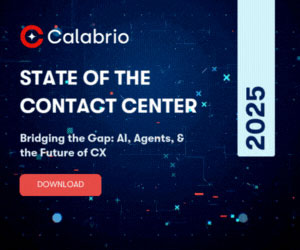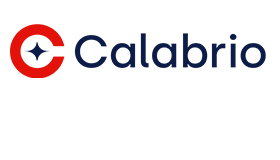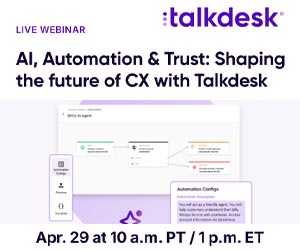Calabrio delves into how to evaluate call centre agent performance effectively, outlining key call centre agent metrics and exploring innovative new techniques – as well as too-often-overlooked ones – to elevate your team’s success.
In today’s competitive business landscape, call centre agents serve as the critical frontline, directly shaping customer perceptions and driving brand loyalty. Consequently, accurately measuring and strategically enhancing call centre agent performance is paramount.
However, traditional evaluation methods, while valuable, often fall short of providing the comprehensive insights needed for continuous improvement.
This is where modern contact centres are turning to cutting-edge solutions, including AI, to deliver real-time performance tracking and more actionable coaching.
Understanding Call Centre Agent Performance
Even in our increasingly AI-driven era, human interactions are still central to the work of contact centres and the value they deliver.
Agent performance is at the core of overall contact centre productivity as well as customer experience quality. In order to improve it, contact centres must be able to measure it. This means, first, they must be able to track the right agent performance metrics.
Call centre agent performance metrics extend – or should extend – beyond a simple count of the number of calls handled. They should encompass a holistic evaluation of an agent’s effectiveness, efficiency, and the overall quality of their customer interactions.
This involves a deep dive into how agents represent your brand, their proficiency in delivering accurate and timely information, their problem-solving capabilities, and their professional demeanor throughout each customer engagement.
To truly understand agent performance, it’s essential to recognize its direct impact on several key business outcomes:
- Enhanced Customer Satisfaction and Loyalty: Agents who excel in their roles create positive experiences, fostering customer satisfaction and long-term loyalty.
- Optimized Call Centre Operational Efficiency: By tracking relevant metrics, call centre managers can streamline operations, reduce average handle time (AHT), and improve first call resolution (FCR).
- Driving Business Growth and Success: Exceptional customer experiences translate to increased customer retention, positive word-of-mouth referrals, and ultimately, significant business growth.
Effectively evaluating and enhancing agent performance ensures a consistent delivery of high-quality service, leading to improved customer experiences and increased retention.
This process requires a strategic focus on key metrics and a commitment to continuous improvement, both of which we’ve explore in greater detail below.
How to Measure & Evaluate Agent Performance: 15 Call Centre Agent Metrics & KPIs to Track
Just as agent performance impacts a range of business and customer experience outcomes, there’s no one way to measure it.
Below, we look at 15 agent performance metrics and key performance indicators, each of which can add to your contact centre’s understanding of strengths and shortcomings in overall performance – at the level of individual agents and larger teams.
1. Customer Effort Score (CES):
CES measures the level of effort a customer perceives they had to exert to resolve their issue. This metric helps identify friction points in the customer journey and highlights areas where agents can streamline processes.
Why it matters: High CES indicates customers are working too hard to get resolutions, leading to frustration and potential churn. Low CES correlates with smoother interactions and higher satisfaction.
2. First Response Time (FRT):
FRT tracks the time it takes for an agent to provide an initial response to a customer inquiry. This is critical for setting the tone of the interaction and minimizing customer wait times.
Why it matters: Rapid initial responses create a positive first impression and reduce customer anxiety, leading to higher satisfaction and perceived efficiency.
3. Average Handle Time (AHT):
AHT calculates the average time an agent spends handling a single customer interaction, encompassing talk time, hold time, and after-call work.
Why it matters: Optimizing AHT balances efficiency and quality; excessively short AHT can sacrifice quality, while long AHT increases costs and wait times.
4. Wrap-Up Time, or After-Call Work (ACW):
Wrap-up time, also known as after-call work, or ACW, measures the time an agent spends completing tasks after a call, such as updating records or sending follow-up emails.
Why it matters: Optimizing ACW improves agent productivity and data accuracy. It can also reveal issues with technology or opportunities for automation.
5. First Contact Resolution Rate (FCR):
FCR tracks the percentage of customer issues resolved during the initial contact, minimizing the need for follow-ups.
Why it matters: Reflects reduced (or increased) customer effort. A higher FCR typically correlates with higher overall customer satisfaction.
6. Call Abandonment Rate:
This metric measures the percentage of callers who hang up before speaking with an agent.
Why it matters: High abandonment rates can indicate potential staffing issues or shortages, as well as long wait and resolution times that may indicate lagging agent performance.
7. Total Resolution Time:
This metric measures the total time it takes to resolve a customer’s issue from beginning to end.
Why it matters: This metric is helpful for considering resolution of complex issues. It’s important to keep this metric low, in order to keep customers happy, but also to make sure that complex issues are resolved correctly.
8. Transfer Rate:
This metric measures the percentage of calls that are transferred to another agent or department.
Why it matters: High transfer rates can indicate agents lack the necessary knowledge or that routing is inefficient, leading to customer frustration and longer resolution times.
9. Agent Utilization Rate:
This metric measures the percentage of time agents spend actively engaged in customer interactions.
Why it matters: Optimizing utilization balances agent productivity and prevents burnout; excessively high utilization can lead to stress and decreased quality.
10. Adherence to Schedule:
This metric monitors an agent’s ability to stick to their assigned schedule.
Why it matters: Consistent adherence ensures adequate staffing levels, minimizing wait times and maintaining service level agreements.
11. Occupancy Rate:
This metric measures the percentage of time agents are directly dealing with customers, or occupied with call-related activities, including hold, talk-time, after-call work, and even related, emails, chats, and time on other non-voice channels.
Why it matters: High occupancy indicates agents are actively engaged, but excessively high rates can lead to fatigue; optimizing occupancy balances productivity and agent well-being.
12. Calls Answered per Hour:
This metric measures the number of calls an agent handles within an hour.
Why it matters: This metric is a general measurement of productivity and efficiency but must be balanced against quality.
13. Service Level:
This metric measures the percentage of calls answered within a specified timeframe.
Why it matters: Meeting service level targets ensures timely responses, impacting customer satisfaction and overall service quality.
14. Customer Satisfaction (CSAT) Scores:
CSAT gathers direct customer feedback on their experience, providing valuable insights into agent performance.
Why it matters: CSAT directly reflects customer perception of service quality, providing valuable insights for agent coaching and process improvements.
15. Net Promoter Score (NPS):
NPS measures customer loyalty by asking how likely they are to recommend your company.
Why it matters: NPS measures customer loyalty and advocacy, providing a long-term view of customer sentiment and its impact on business growth.
Some of these metrics stretch the bounds of what might be correctly termed an agent performance metric – but that’s the point. Agent performance, in many ways, is contact centre performance, customer experience performance, and more.
It’s only by diligently tracking the right mix of these call centre agent performance metrics that you can begin to gain a more comprehensive understanding of your team’s strengths and weaknesses – as well as identify other potential causes of performance issues – enabling you to implement targeted strategies for continuous improvement.
Turning Metrics into Action: 10 Strategies for Improving Agent Performance
Simply tracking call centre agent performance metrics is just the start. The real value lies in leveraging these insights to drive meaningful improvements.
This section explores actionable strategies for translating data into tangible results, focusing on coaching, training, and process optimization.
We’ll delve into how to identify performance gaps, implement targeted interventions, and foster a culture of continuous improvement within your call centre.
By effectively utilizing the data gathered from the 15 metrics we discussed, you can empower your agents, enhance customer satisfaction, and achieve your business objectives.
Here’s how to get started:
Invest in Agent Engagement
A highly engaged agent is a productive agent. To support sustainable improvements in agent performance, make evaluating and supporting agent engagement your north star.
Foster a positive work environment by recognizing achievements, providing opportunities for growth, and soliciting agent feedback.
Engaged agents are more likely to deliver exceptional customer service, leading to improved CSAT and FCR. Create team-building activities, implement recognition programs, and ensure open communication channels.
Create and Develop a Knowledge Base
Equip your agents with a comprehensive and easily accessible knowledge base. This empowers them to quickly find accurate information, reducing AHT and improving FCR.
Regularly update the knowledge base with the latest product information, troubleshooting guides, and FAQs. Implement a search function and ensure it is easy to navigate.
Balance Your Contact Centre’s Workloads
Adopting a proactive, rather than reactive, workforce management approach is crucial to overall agent performance. Get ahead of issues, avoid agent burnout, and meet customer demand efficiently with the help of sophisticated forecasting and scheduling tools.
Leverage historical data, seasonal trends, and predicted call volumes to accurately forecast future demand.
This allows you to optimize staffing levels, ensuring adequate coverage during peak periods and minimizing idle time during slower periods, while preventing both added agent stress from overwork and wasted resources from underutilization.
Monitor for Signs of Stress and Burnout
After years of high contact centre turnover rates, organizations need to take a new approach. Proactively address agent stress by monitoring for signs of burnout, such as increased absenteeism, decreased productivity, and negative customer interactions. Implement regular check-ins, provide stress management resources, and encourage a healthy work-life balance.
Offer Flexibility with Self-Scheduling Tools
One way to improve work-life balance while fostering a sense of ownership is to empower agents with self-scheduling tools.
Offering agents the ability to manage their own schedules provides them with greater flexibility and control, leading to reduced stress, increased job satisfaction, and improved adherence.
This autonomy allows agents to better accommodate personal needs, resulting in higher morale and reduced absenteeism.
Empower Agents with Self-Service Insights
Complement self-scheduling with accessible, self-service performance reporting that empowers agents without requiring data expertise.
Implement intuitive dashboards that provide agents with real-time access to their KPIs in a user-friendly format. These tools should present data visually, using charts and graphs, and offer clear, concise explanations of each metric.
This allows agents to easily track their progress, identify areas for improvement, and take proactive steps to enhance their performance.
By making performance data readily available and understandable, you foster a culture of self-improvement and accountability, while also unlocking clear development paths and freeing up managers from routine reporting tasks.
Add Improved Customer Self-Service to the Mix, Too
Reduce call volumes and empower customers by providing robust self-service options. Implement intuitive IVR systems, comprehensive FAQs, and AI-powered chatbots to handle routine inquiries, freeing up agents to focus on complex issues. This can improve customer experience and reduce AHT.
Monitor Customer Feedback Across All Channels
Gain a holistic understanding of the customer journey by implementing a unified monitoring solution that captures contact centre agent interactions across all channels.
This technology provides a complete and accurate record of voice calls, chat sessions, emails, social media interactions, and other communication channels.
What’s more, by consolidating interaction data into a single platform, you can go beyond high-level metrics and, with the help of voice analytics and sentiment analysis tools analyze agent performance across all touchpoints, identify areas for improvement, and ensure consistent service quality.
This comprehensive view empowers you to understand customer sentiment, identify trends in customer behavior, and resolve issues quickly and effectively.
Engage in Continuous, Personalized Training and Development
The vast majority of customers prefer personalized interactions with brands. With agents themselves, it’s no different.
Why deliver cookie-cutter coaching and training experiences, when you can offer a more personalized development approach that drives results by:
Adapting performance goals based on real-time data. By deploying AI-driven performance management solutions, you’re able to automatically set performance goals based on recent data and modify them according to the required business outcomes.
Acknowledging and reward outstanding performance. Recognition is a powerful motivator and encourages the agent to set a benchmark for others in the team to strive for excellence.
Establishing targeted improvement strategies for underperforming agents. Focus on support and progress rather than punitive measures. Provide personalized coaching and additional training resources tailored to improving the skills where agents require the most help, according to your data.
Support Feedback and Coaching with AI and Automation
Elevate agent performance by implementing automated quality management tools that enable the evaluation of 100% of interactions across all channels.
These advanced solutions leverage AI and machine learning to automatically analyse conversations, identify key performance indicators, and deliver targeted, personalized, and unbiased insights to agents more quickly than manual review processes.
As you accelerate the delivery of feedback, you also eliminate subjectivity and ensure consistent evaluation standards. Agents can take immediate steps for course-correction and continuous improvement.
This accelerated feedback loop enables targeted coaching, personalized training, and ultimately, a more efficient and effective contact centre team. Automating this process removes the time burdens of manual review, and allows a supervisor to look at more data points and provide better feedback to their team.
This blog post has been re-published by kind permission of Calabrio – View the Original Article
For more information about Calabrio - visit the Calabrio Website
Call Centre Helper is not responsible for the content of these guest blog posts. The opinions expressed in this article are those of the author, and do not necessarily reflect those of Call Centre Helper.
Author: Calabrio
Reviewed by: Megan Jones
Published On: 28th Apr 2025
Read more about - Guest Blogs, Calabrio






 The digital foundation of a customer-centric contact centre, the Calabrio ONE workforce performance suite helps enrich and understand human interactions, empowering contact centres as a brand guardian. Calabrio ONE unites workforce optimisation (WFO), agent engagement, and business intelligence solutions into a cloud-native, fully integrated suite.
The digital foundation of a customer-centric contact centre, the Calabrio ONE workforce performance suite helps enrich and understand human interactions, empowering contact centres as a brand guardian. Calabrio ONE unites workforce optimisation (WFO), agent engagement, and business intelligence solutions into a cloud-native, fully integrated suite. 




























